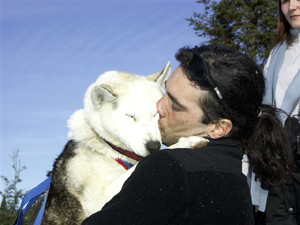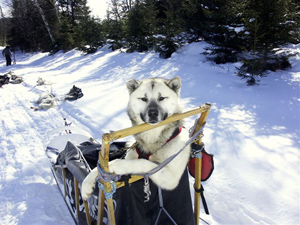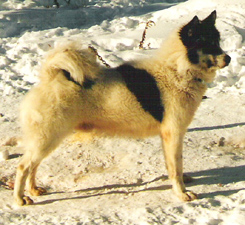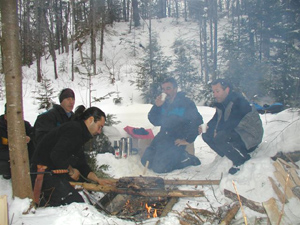Table of Contents
*
Fan Mail
*
F.I.D.O.: Ludovic Pirani
*
Geronimo's Travels
*
The Breeding and Maintenance of Sledge Dogs: Part I
*
How We Met Tom
*
Dog Yard Tips
*
Setting a New Standard
*
In the News
*
Behavior Notebook: Qiniliq and Sunny
*
IMHO: Unnecessary Roughness
Navigating This
Site
Index of articles by subject
Index
of back issues by volume number
Search The
Fan Hitch
Articles
to download and print
Ordering
Ken MacRury's Thesis
Our
comprehensive list of resources
Talk
to The
Fan Hitch
The Fan
Hitch home page
ISDI
home page
Editor: Sue Hamilton
Webmaster: Mark Hamilton
Contents of The Fan Hitch Website and its publications are protected by international copyright laws. No photo, drawing or text may be reproduced in any form without written consent. Webmasters please note: written consent is necessary before linking this site to yours! Please forward requests to Sue Hamilton, 55 Town Line Rd., Harwinton, Connecticut 06791, USA or mail@thefanhitch.org

Ludovic Pirani and
Kayla
Pirani
photo
Ludovic Pirani
TFH: Where do you live?
LP: I came from France to live in the Outaouais
region, Québec
(Canada) in 2000.
TFH: How many dogs do you have?
LP: Ten males and five females for a total of
fifteen dogs,
fourteen ISDs and one Siberian Husky.
TFH: How long have you had ISDs?
LP: I have owned Greenland Inuit Dogs since 1994.
TFH: How did you come to the Inuit Dog?
LP: My first three arctic dogs were Alaskan
Malamutes. They
were very beautiful dogs. However, when working they were
not responding
to my needs. Afterwards, I met people who owned Greenland
Dogs. I exchanged
a lot of information with them for about two years before
I decided to
buy my very first Inuit Dog. What seduced me was their
power, their devotion,
their behavior and force of character. They are honest and
loyal dogs.
After I met with two people who traveled through Siberia
with their dog
team, I knew that my decision to own Greenland Dogs was
the right one concerning
my future plans.

Kodiak
Pirani
photo
TFH: What did you do to realize those plans?
LP: I met with a few Greenland Dog breeders. After
a few discussions
and meetings and, using my knowledge, I was able to tell
which breeders
were selling their dogs for money and which ones really
knew what they
were talking about due to their incredible passion and
love for the breed.
One year after buying my first dog, I decided to buy two
more to give more
power to my team. I arrived in Canada with my remaining
two Malamutes and
three Greenland Dogs.
TFH: What activities do you do with your dogs -
recreational
or commercial?
LP: During the summer, I work in construction. In
winter, I
hire my guiding services to dog sledding enterprises. In
conclusion, I
give myself the opportunity to enjoy winter with my dogs
and to make it
a reasonable living. I love my work. However, I don't want
my work to kill
my passion for dogs. I want to share with my clients my
love for the Inuit
Dogs, for the nature and for its wide white spaces.
TFH: How do you train your dogs?
LP: To train my dogs I use an ATV. The first
training starts
late September on short distances and end when the snow
arrives. In between,
the training distance increases throughout the autumn
season as the power
of the dogs increases.
TFH: What do you feed your dogs in summer and in
winter?
LP: In summer, the dogs eat dry pet food (26%
protein and 16%
fat) mixed with chicken and canola oil. During the winter
I use the same
dry food however with 30% protein and 20% fat mixed with
beef and or horsemeat
and canola oil.
TFH: What criteria do you use when choosing a
dog?
LP: I use several criteria to choose a dog. I
prefer to buy
my dogs from a breeder who works his dogs. The reason is
simple. I work
with them. I don't want the most superb stud if I have to
leave him in
his pen when I go out with the team because he is a bad
worker. I leave
that to breeders who are trying to preserve the breed in a
different manner
than mine. There is a need for every sort of breeders and
every type of
personal works to preserve a breed. Personally, I chose
the working dog.
Not because it is better but because that's what I do. I
like to see them
hitched up regularly, see them work in their environment
doing what is
natural to them - pull a sled. Every time I bought a dog
from a working
kennel, from working parents, I have never been
disappointed. Maybe luck?
My conclusion is that the physical aptitudes of a dog
whose parents were
working are innate.

Ourko
Pirani
photo
TFH: What makes you reject a dog?
LP: In my team, I don't reject any dogs because of
their character.
Even the most fearsome dogs don't scare me. There is
always a solution
to this type of problem. If I must reject a dog, it's
mainly due to a physical
problem.
TFH: Let's talk about purity. What is your
definition?
LP: To tell you the truth, I must say that my
criteria for selection
are still very much influenced by my experiences in
France. I am using
a recognized standardized method based on the Club de
Race, with all its
obligations and veterinary examination (x-ray, dysplasia,
eye exam...).
In France, the criteria for purity are determined by
qualified judges who
will award the registration papers after examining a
litter. They take
into consideration the genealogy of the parents. If there
is any doubt,
blood work is ordered to verify that the litter has been
sired by the correct
dog.
Here in Canada, things are different and I try very hard to adapt myself. I don't know all the studies that were made on this subject. Adding to this is the language (English), which I haven't fully mastered and everything becomes very blurry for me. Presently, my efforts mostly consist of research in the origin of the Canadian Inuit Dog and Greenland Dog. Is it the same dog? I do not know! Historically, it is logical that it is the same dog. Geneviève Montcombroux, in Canada and Jean Luc Delente, in France, are helping me the most that they can. They are real sources of data. All this to know what I can and can't do concerning the "purity" of the Inuit Dog.
TFH: In North America, few Inuit Dogs are
registered with the
Canadian Kennel Club. Have you had the opportunity to see
registered dogs?
And if yes, was there a difference?
LP: The answer is yes and no. I saw non-registered
dogs that
were very ugly, that did not correspond at all to the
Inuit Dog standard.
I also saw registered dogs that were very pretty
corresponding perfectly
to the standard. However, I also saw the opposite. My
conclusion for this
story is that registered or not everything depends on the
owner (breeder),
their ideas, their principles and their expectations,
either, professional,
passional, sportsman-like or ...FINANCIAL!
TFH: Let's talk about fights. How do you deal
with the inevitable
fights in your team?
LP: It all depends upon the different situation in
which I'm
in the moment the battle explodes. With the clients’
teams, I do not tolerate
any battle of any sort. Often, I will change the "guilty
dog" with another
one. I will even put them in my sled if I have to. It is
hard to deal with
these conflicts when the clients are around. In general,
my dogs listen
to the sound of my voice and will often stop fighting.
However, if this
persists I need to involve myself physically. At the
kennel, when it comes
to huge fights (possession or power), I let the dogs
"explain each other"
once and for all as I secretly watch the action from
behind. I let no other
dogs close to them as they settle their differences. The
more I interfere,
the more disaster it will cause if and when the battle
explodes. In conclusion,
it takes two to tango! It depends what type of fight.
Three quarters of
the time, the dogs respond to my voice. I always have a
small aluminum
snow shovel with me. It makes a loud noise. As long as
they are not hit
on the head, muzzle or other sensitive points, it does not
harm them. I
use the effect of surprise to intervene between two
quarreling dogs. Moreover,
when I enter a fight it is not gently with a soft voice.
I'm six feet tall
and weigh 200 pounds, so when I arrive to separate them it
is with a lot
of speed and yelling. For the smaller battles, I have
enough authority
over my dogs to separate them with the sound of my voice.
I respect and
accept them the way they are with their laws and
hierarchy. I do not interfere
in the structure of the group. Even if my favorites dogs
are being displaced.
All of this is difficult, however inevitable... it's the
breed that wants
it that way!

Ludovic and his clients around the
campfire
Pirani photo
TFH: How do you tell clients that the ISD is nice
to people and
that fighting in the pack is pretty normal?
LP: It is out of the question to put any type of
fighting dogs
with the clients... security and pleasure being my first
concerns. I warn
the clients that due to the nature of the dogs, there may
be a fight breaking
out but that they will never hurt people as long as you
don't go and stand
between the fighting dogs. I try to give my clients a
group of dogs that
is uniform in strength and compatibility of character. I
arrange the teams
so that the clients only drive no-problem dogs. I
give them a lecture
on the ISD and mention their propensity to fight - because
you never know
when the mildest dog is going to take exception to his
neighbor. If a few
dogs have problems to solve when they are working, I put
them with my team
when taking out clients.
While out with my clients, I transform myself into a history and sociology teacher. I explain to them the migration of the first men and the fine line that they cultivated with their dogs. Before the modernization of transport, survival of these men and dogs depended mostly on the collaboration they had between each other. The survival of the men depended on their dogs and vice versa. There is a lot to say on this subject however, the list is way too long. I don't tell the clients everything on the first day since I keep some information for the long nights next to the fires all along the journey. The majority of the clients know a little about the sometimes violent reaction of the Arctic dogs and whatever the breed is. What the client doesn't know, and that I explain to them, is the cause of the battles. They are often surprised to learn that the majority of the battles on a trip are caused by a person who might pet a dog or give him a treat and the other dogs get jealous. They find this interesting and immediately correct the situation by either petting all the dogs or none.
TFH: What are your plans for the future?
LP: My personal projects are for three unsupported
expeditions:
1) from Natashquan to Blanc Sablonc, the north shore of
the St. Lawrence
River where it becomes the Gulf of St. Lawrence. Blanc
Sablonc is the point,
where it narrows between Newfoundland and Quebec, where it
is sparsely
populated. 2) along the Labrador coast. 3) along the
western shore of James
Bay. I want to live some big adventures (1,000 km +) alone
with my dogs.
I want to live with them in their world and travel by the
oldest transport
means: the sled. And I want to see the fabulous landscape
of our magnificent
country. In the near future, it is in my plans to develop
this type of
expedition. It demands a lot of thoughts and preparation.
My professional project is to develop my own tourist enterprise
My project for the dogs is to preserve and protect the Inuit Dog breed (Canadian or Greenland) the best that I can by keeping contact with breeders here in Canada and Europe.
TFH: Anything else you want to add?
LP: The conclusion is that the Inuit Dogs are soft
with human
beings but rough between one another. The clients also
discover this reality
after spending six days in the forest with me and a team
of Inuit Dogs.
There is nothing better than life in common with these
dogs to learn to
better understand these wonderful and magnificent dogs -
the best friend
a man can have throughout adventure.